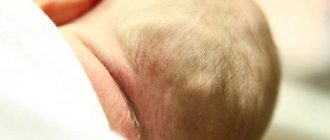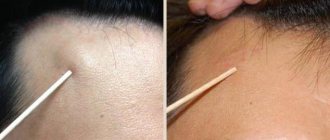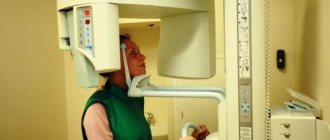What is a concussion?
The brain of every person is in a “suspended state” in the cranium. Brain tissue does not come into contact with bones thanks to cerebral fluid, which keeps the hemispheres “afloat”. If the head hits something, the brain begins to rapidly move towards the bone tissue and hits the skull. In this case, a shift in brain structures occurs. Not only brain tissue is displaced, microcracks can occur in large vessels, capillaries rupture, and neuronal communication is disrupted.
In case of injury, a person may receive a concussion or bruise of the brain. Depending on the damage sustained, the patient may have a mild, moderate, or severe concussion of brain tissue.
The degrees are determined by the neurological signs exhibited, as well as by how quickly the symptoms of damage to brain tissue increase. Fever during a concussion can occur in moderate to severe stages of brain tissue damage.
(UGM) Brain contusion and concussion: difference. First aid
Damage to brain tissue , in which a necrotic focus is formed, develops as a result of a bruise . The risk group is children and young people, and men are injured 2-3 times more often than women.
When you hit your head in the area of the injury, a condition is formed when an increase in pressure occurs at the site of the impact, and a decrease in pressure at the site of the counter-impact. This pressure drop is very short-term, but leads to the destruction of nerve cells. And the stronger the blow, the larger the area affected.
Photo 1. Brain contusion is an injury that can be fatal. Source: Flickr (Southwest Brain Performance)
Note! Do not confuse a bruise with a concussion. Despite the similarity of symptoms, a concussion is a milder injury that is not accompanied by organic changes.
Reasons for the development of bruise
The injury always develops as a result of hitting the head on hard objects , as well as due to either an intentional or accidental blow.
Traumatic brain injury occurs:
- in everyday life, during daily activities;
- in children due to the anatomical structure of the body, increased physical activity and poorly developed ability to coordinate their movements;
- during a traffic accident involving any type of transport;
- while playing sports (the risk category includes all “combat” and extreme sports);
- in production , often when safety rules are not followed;
- in a fight or when intentional physical harm is caused by third parties;
People with neurological or cardiac conditions are often susceptible to injury, causing sudden loss of consciousness. So, during an epileptic seizure, the patient suddenly falls and may hit his head on nearby objects or on the ground.
Note! In most cases, brain contusion in adults occurs due to non-compliance with safe behavior standards, as well as under the influence of alcohol.
Classification
The injury can be open, that is, damage to the skin is observed, and blood vessels are also affected. If the injury is penetrating, then the dura mater of the brain is affected, sometimes a fracture of the base of the skull is diagnosed - one of the most dangerous injuries.
With closed injuries, the skin is not injured. The following groups of brain damage have been identified:
- A concussion is a mild degree of traumatic brain injury, the manifestations of which disappear after a few days, there are no symptoms of vascular damage, and functional disorders are reversible. A bruise is a more severe injury and may cause brain damage. Manifested by such symptoms as nausea, vomiting, pale skin, tissue swelling, pain.
- compression of the affected area of the brain (foreign object, hematoma, air, bone fragment);
- hemorrhage in the subarachnoid space (the cavity between the arachnoid and pia mater);
- diffuse damage.
Types of bruises
The classification of brain injuries depends on the location : most often, injuries are recorded to the back of the head and temporal lobes, which usually receive blows to the head. Frontal and parietal bruises are much less common.
According to the clinical picture, there are 4 forms of brain injury:
- Extrapyramidal . Damage to the cortex and subcortical formations is expressed in impaired motor activity.
- Diencephalic . Damage to the hypothalamus is accompanied by general hyperthermia, tachypnea (slow breathing), increased blood pressure, as well as various types of hallucinations.
- Mesencephalic . The most pronounced symptom is visual disturbances: involuntary rhythmic movement of the eyeballs (nystagmus), strabismus, significant constriction of the pupil (miosis) or, on the contrary, its dilation (mydriasis).
- Mesencephalic-bulbar . It is characterized by brain damage with suppression of functions: swallowing and speech disorders, low blood pressure, decreased body temperature, bradycardia.
The most common classification of bruises of the brain divides injuries according to the intensity of symptomatic manifestations.
1st degree bruise
At the time of injury, loss of consciousness occurs (from several seconds to 5 minutes). Headache and dizziness, weakness, nausea occur . Blood pressure often rises, temperature rises, and pulse rate changes.
2nd degree bruise
The patient remains unconscious for several hours . Upon regaining consciousness, the victim experiences a severe headache. Repeated vomiting occurs. There is an increase in blood pressure, tachycardia or, conversely, bradycardia. Mental and perception disorders are often present.
When the skull bones are fractured due to TBI, hemorrhage is possible.
3rd degree bruise
Severe trauma during which the victim may fall into a long-term coma . When nerves are damaged, paresis and paralysis of various muscle groups develop, meningeal and brainstem manifestations are pronounced (muscle rigidity, hyperesthesia, nystagmus, etc.). With such lesions, when the heart and respiratory centers of the brain are affected, death is quite likely.
Symptoms of concussions and bruises in adults
Manifestations of concussion are not always observed. Often a person does not realize that he has a pathology.
A concussion in an adult patient is characterized by: nausea, vomiting, dizziness, lethargy or the opposite state - euphoria, short-term memory loss, fainting, but not more than 5 minutes. In addition, the patient’s skin is pale, sweating and tachycardia appear. A person experiences ringing in the ears and drowsiness.
Source: https://rptp-rd.ru/rasstrojstva/ushib-mozga-simptomy-i-posledstviya.html
How do children get injured?
In children, head injuries quite often lead to concussions. And even babies are not immune to such brain damage. Children under one year old fall from strollers, changing tables, and beds. The reason is not only the oversight or carelessness of parents. Sometimes mothers and fathers cannot objectively assess the baby’s activity level; they calmly leave him on an open surface, confident that the baby will not be able to turn around or crawl.
Typically, fever during a concussion in children under one year of age is not a consequence of injury. Often the reason for this phenomenon is that literally all babies of this age are teething. Violation of the integrity of the gums leads to inflammation of the mucous membrane and a rise in temperature.
Even more injuries occur in children who are just starting to walk. Even a very mother will not be able to protect her child from collisions with tables, doors and corners of cabinets. In addition, babies have a shifted center of gravity, so when they begin to learn to walk, they fall and usually hit their heads, since they do not yet know how to put their hands up or group themselves.
In preschool age, children receive head injuries when falling from slides, scooters, or bicycles. Among schoolchildren, the percentage of concussions is even higher. The reason is increased mobility, inability to assess one’s capabilities. In children who have suffered a concussion, the temperature does not always rise, and this may go unnoticed by parents, since not all children talk about the incidents at home. Schoolchildren suffer head injuries:
- In physical education lessons when performing somersaults and jumps.
- During recess: if you hit the wall of the person in front of you with all your might, the displacement of your brain structures is guaranteed.
- At home - when jumping out of bed, on stairwells.
- In street fights.
Childhood injuries are dangerous because the child may consider the injury not significant and hide the fight for fear of being punished. Gradually, the victim’s condition worsens, because the child does not know that he cannot move, watch TV, and must remain in bed. As a result, severe cerebral edema develops, the student loses consciousness, and may fall into a coma.
Signs of a concussion in an adult
In case of a severe concussion, it is necessary to provide first aid to the patient even before the arrival of doctors. Can there be a fever with a concussion? In the first minutes after injury, such a symptom does not appear. Characteristic signs of a concussion:
- Darkening in the eyes.
- Involuntary twitching of the eyeballs.
- Nausea.
- When moving, turning the head - dizziness.
- Noise in ears.
- Arrhythmia, tachycardia.
- Drowsiness.
- Numbness on one side of the face, loss of sensitivity in the fingers.
- Loss of consciousness.
- Fainting.
Consequences of temperature disturbances in head trauma
After an injury, if it is complicated by an increase in temperature, the following symptoms persist indefinitely:
- increased fatigue;
- irritability;
- weakening of attention and memory;
- sudden change of mood;
- apathy;
- slight dizziness;
- nausea, vomiting.
So, a concussion is sometimes accompanied by fever and fever. There are two reasons for this - natural (disruption of neural connections due to injury) and pathological (infection during severe traumatic brain injury, inflammation due to another disease). In both cases, the patient must be under the close supervision of a doctor and follow his recommendations. If you consult a doctor and strictly adhere to the prescribed treatment regimen, the risk of complications will be minimized. If you ignore the advice, then there is a possibility of complications even if the concussion was mild and occurred without fever.
How does a concussion manifest in a child?
Infants and preschool children rarely experience loss of consciousness after injury. They cannot tell anything at all about a head injury, and parents who did not see that their child fell should be guided by warning signs. The temperature during a concussion in a child, as in an adult, immediately after the injury remains stable. Other symptoms of brain damage are noted. In a baby:
- Brain scream caused by severe pain in the head (incessant screaming, the baby starts crying).
- The baby's gaze does not focus on one point.
- A strong pulsation of the fontanel is noticeable.
- The baby breaks into a sweat, his skin turns pale.
- The baby spits up profusely like a fountain.
- Involuntary convulsions appear.
- The baby suddenly falls asleep, sleeps nervously, often jumps up, or, conversely, cannot be woken up.
Older children experience similar symptoms, but they may also complain of nausea, vomiting, severe headache, and a feeling of heaviness in the head. The injured child cannot tell where he was injured, and his speech may be incoherent.
Although the temperature during a concussion in children may rise only after some time, if the numbers exceed 37.2 and a combination of the above symptoms (even two of them) appears, you should immediately consult a doctor.
Does a fever occur with a concussion in adults? How much can it rise?
A concussion is one of the clinical forms of traumatic brain injury. The traumatic brain injury itself is a damage to the tendon helmet.
In the case of a concussion, there is no organic damage to the substance of the brain, which hits the skull during a strong shock; only general cerebral symptoms occur.
Find out from the article whether a person has a fever during a concussion, and how to provide first aid.
Symptoms of concussion in children and adults
Below is a list of concussion symptoms in children.
- Brief loss of consciousness.
- Headache in older children or restless behavior in infants.
- Nausea and vomiting.
- A sleep disorder can manifest itself as either insomnia or hypersomnia.
- Temporary loss of vision is rare.
- Inability to focus vision.
- Children compensate for the injury for a long time, feel satisfactory, but then develop a rapid deterioration in their condition.
- Sometimes the temperature rises.
Watch a video about the symptoms of concussion in children:
In adults, clinical manifestations are generally similar . Below is a list of the main symptoms of a concussion in an adult.
- In the acute period, loss of consciousness lasts from several minutes to half an hour.
- Amnesia for events preceding the trauma or for those occurring immediately after.
- Headache.
- Nausea and single vomiting.
- Possible increase in temperature.
- Visual impairment in the form of temporary blindness.
- Lethargy, sweating, decreased performance, absent-mindedness.
- Nystagmus in the direction of damage.
Attention! If symptoms from the above lists appear, you must contact a traumatologist to diagnose the pathology and provide assistance.
Watch a video about the symptoms of a concussion in an adult:
Can there be a fever with a concussion?
Let's consider whether the temperature can rise during a concussion. As can be seen from the symptoms, a rise in temperature can accompany a concussion . To understand the mechanism of hyperthermia, you need to understand that in the human body there are clusters of nerve cells called nerve centers. They are part of the structure of the central nervous system.
During a concussion, brain detritus does not form, but its structures can be displaced and damaged without cell death. The hypothalamus is the center of thermoregulation. When it is damaged, the function of body temperature control is impaired. The hypothalamus can be damaged as a result of edema.
There is another variant of the etiology of fever. Autonomic disorders caused by concussion. In this condition, the blood vessels dilate, which contributes to an increase in body temperature.
Hyperthermia is also . In this case, hypothermia occurs with subsequent expansion of the capillaries or the addition of an infectious pathology.
Another reason is the mental state of the patient. Doctors distinguish the concept of thermoneurosis, in which non-steroidal anti-inflammatory drugs have no effect, but they manage to cope with the infectious version of hyperthermia.
Important! When hyperthermia occurs, there is always damage to the hypothalamus, which contains other important nerve centers. In the event of an increase in temperature, it is necessary to inform the doctor about this in order to diagnose the phenomenon, correct treatment or hospitalize it in specialized hospitals.
The temperature rises to a subfebrile level; neurologists note that it usually takes about a week to restore connections between neurons and normalize the temperature. At this time, the patient needs peace, absence of emotional excitement and sleep for at least 8 hours.
First aid for TBI
If you receive a TBI, you should consult a doctor.
The danger of self-medication is that the clinical picture is often blurry; a concussion in children is confused with an ordinary bruise, especially considering the length of time the child has been compensating for the pathology. Adults may also have no symptoms.
With an increase in temperature, during or after a brain injury, as noted above, swelling of the hypothalamus is possible, and due to the lack of adequate diuretic therapy, severe complications can occur.
- Immediately after receiving an injury, you need to call an ambulance, and the victim must be laid on his side, taking into account the side of the injury. If this is not possible, place it on a horizontal surface with the head end raised.
- If the patient is conscious, this must be supported by conversation. If a child is injured, he should also not be allowed to sleep.
- Open lesions of the skin and tendon helmet are treated with hydrogen peroxide, but a cold compress is applied to the forehead.
- The victim is transported only on a stretcher. Hospitalization is carried out in a traumatology, neurological or surgical department.
We invite you to watch a video about first aid for a concussion:
The temperature that appears after a concussion cannot be brought down with pills!
- This is a diagnostic criterion.
- Allergies are possible, which will only worsen vascular reactions and the general condition of the patient.
- If the victim vomits, a drop in temperature can cause a new attack and asphyxia is possible.
It is not recommended to give any medications before consultation with medical professionals.
What is the connection between rising body temperature and brain damage?
After some time, the victim's body temperature may rise. Neurologists note that numbers on a thermometer in the range of 37.0-37.5 are normal. The reason is that with a concussion, a person’s thermoregulation may be disrupted due to a displacement of the brain structures responsible for these functions. It usually takes at least a week for neuron connections to return to normal and the functioning of thermoregulatory centers to improve.
Another reason for fever is the occurrence of an inflammatory process in the victim’s body. It can occur even earlier, before the injury. The temperature during a concussion in a child who has had a cold rises already on the day of injury and can reach 38.5.
Sometimes the victim's fever is accompanied by a runny nose, and he complains of a headache. Symptoms similar to a cold can be caused by swelling of the brain.
A rise in temperature should alert parents. Fever may be a sign that the brain has been significantly damaged, there are vascular ruptures, and an inflammatory process has begun in the medulla. A concussion can provoke the development of meningitis - inflammation of the meninges, accompanied by a rise in temperature to 40-42 degrees.
High temperature after a concussion: what is the danger?
A concussion is usually called a mild traumatic brain injury without damage to the bones of the skull. Sometimes it is accompanied by a short loss of consciousness (up to 5 minutes). Subsequently, many patients complain of headache, dizziness, vomiting, and insomnia. The injury may also be accompanied by a fever. The article indicates the mechanisms of this symptom and ways to eliminate it.
What is a concussion?
The brain is a fragile, vulnerable and at the same time very important part of the body. It is not for nothing that its two hemispheres are hidden in a strong, reliable box - the skull.
However, they are not fixed there, so during impacts, shaking, and other physical impacts they can easily move and hit the bones of the skull.
In this regard, damage occurs to the brain tissue or brain substance itself, as well as blood vessels and intracerebral fluid.
The extent of damage depends on the force applied and ranges from molecular changes in the medulla to collection of blood (intracranial hematoma).
One of the signs of such disorders is the temperature that occurs during a concussion.
The causes of pathology can be different influences:
- a typical case for passengers is a sharp shake of the head during sudden sharp braking of a vehicle;
- a strong blow to the head;
- falling (for example, due to fainting or ice);
- jump from height;
- In infants this occurs when motion sickness is too active.
Why does the temperature rise during a concussion?
Is there a symptom of fever with a mild concussion? In itself, exceeding the normal body temperature, as a rule, indicates the presence of an inflammatory process.
If the temperature has increased significantly - above 38 ° C, then it can be assumed that as a result of the concussion, inflammation develops in the damaged part of the brain, or it began even before the injury.
High temperature may be a manifestation of:
- ruptures of blood vessels;
- meningitis (inflammation of the meninges);
- cerebral edema.
It should be remembered that an uncomplicated concussion is characterized by quickly passing symptoms, such as headache. While elevated temperature is a very dangerous symptom that cannot be ignored. Immediate hospitalization, examination and treatment are required.
It is worth noting the exception to the rule: a slight increase in body temperature. Readings in the range of 37.0-37.5°C are considered normal. This is a failure of thermoregulation resulting from a concussion. It is believed that within 7-10 days, neural connections return to normal, and along with them, body temperature.
Other symptoms of a concussion
Having considered the question of whether there can be a temperature during a concussion (or, in medical terms, concussion), let’s move on to other manifestations. Clinical symptoms depend on how severe the concussion was.
A mild degree is characterized by the following symptoms:
- darkening of the eyes;
- visual effects of “sparks from the eyes” and “floaters in front of the eyes”;
- loss of consciousness for a short time;
- dizziness;
- insomnia;
- nausea and vomiting.
If a moderate degree of concussion occurs, the following symptoms are likely:
- surges in blood pressure and pulse;
- hematomas;
- headache, which is aggravated by sound and light;
- fainting;
- impaired movement coordination
- amnesia.
The severe form is characterized by worsening symptoms to the point of hallucinations, delusions, paralysis, seizures, and repeated vomiting. The patient needs urgent medical help.
Experts note some features of the clinical picture in children and the elderly:
- Babies develop drowsiness, increased regurgitation, and anxiety.
- Preschoolers complain of general weakness, nausea, and nervousness. Sometimes there is temporary blindness - a post-traumatic visual impairment that should go away in a few minutes or hours.
- Elderly people may suffer from disorientation in time and space and complain of memory loss. Those who suffer from high blood pressure may experience throbbing pain in the back of the head.
How long does the temperature last after a concussion?
If a concussion is accompanied by a slight increase in temperature, then you should wait 7-14 days.
Exceeding the normal temperature (intense heat of about 40°C) indicates that a serious pathological process has started in the tissues, which can develop rapidly and lead to the death of the patient in a matter of days.
For example, meningitis is very dangerous, so when the numbers on the thermometer go off scale, you can’t wait quietly. Hospitalization and emergency measures are required.
Is it necessary to reduce the temperature during a concussion?
The answer to the question of whether it is worth lowering the temperature during a concussion depends on whether there is a strong fever. In mild cases, special artificial reduction is not required. Advice in each specific case should come from the attending physician.
Generally speaking, the following action plan is recommended:
- Bed rest in a darkened, quiet room (walk maximum until the toilet).
- A gentle diet without spicy, salty, smoked dishes.
- Watching videos and even reading are prohibited.
- Taking diuretics (to relieve tissue swelling).
- Taking medications containing potassium (to nourish the heart).
- Taking Nootropil to increase blood circulation in brain tissue.
- If specifically prescribed by a doctor, use sedatives to relieve anxiety.
- Painkillers - to relieve headache syndrome.
- Means to reduce fever (according to a doctor's prescription).
- In case of severe vomiting, you need the drug Regidron to prevent dehydration.
In mild cases, the patient remains at home during the recovery period. By following these recommendations, you can achieve rapid improvement in your condition. If the temperature continues to remain high for more than 2 weeks, you need to consult a doctor again.
Treatment of concussion with fever
A concussion is a complex pathology, and the symptoms are often vague. An imaginary relief of the condition (such as a decrease in temperature) can turn into a sharp deterioration. Thus, you can miss precious time for treating severe, rapidly occurring pathologies - internal hematomas, cerebral edema, meningitis.
Therefore, it is recommended to immediately call a doctor and schedule a consultation with a neurosurgeon or neurologist. Based on the clinical picture, history and diagnostic results, an accurate diagnosis is made.
The following modern and informative diagnostic methods are used:
- X-rays are a standard test that most patients undergo. Although it does not provide a picture of the state of the brain, it can reveal the presence or absence of skull fractures.
- Ultrasound (neurosonography, echoencephalography) can determine whether the medulla and ventricles of the brain are normal. Bruises and hematomas are diagnosed.
- Computed tomography provides layer-by-layer images of the brain and skull bones.
- Electroencephalography studies the neural activity of the brain. Can detect epilepsy and other pathologies.
Treatment methods are determined by the severity of the condition and the presence of serious brain disorders. In most cases, after examination and examination, bed rest at home is prescribed, as mentioned earlier. In more complex situations, the patient is hospitalized.
First aid consists of placing the patient on a flat surface and raising the head. If he does not come to his senses after fainting, they place him on his right side so that he does not choke on vomit. Further treatment depends on the diagnosis.
Consequences of temperature disturbances in head trauma
If the patient, with the help of his relatives and medical staff, follows all the instructions of the attending physician, then, most likely, he will experience a natural decrease in temperature and a complete cure in the next 2 weeks. Even if the consequences of the injury occur with a low temperature background, the condition will return to normal.
In rare cases, patients experience a decrease in concentration, memory deterioration, causeless anxiety, insomnia, fatigue, or, conversely, excitability.
Periodic dizziness, anxiety, irritability, headache, fatigue, insomnia, and sensitivity to light may occur.
These phenomena disappear no later than a year after the injury.
However, in 3% of patients the consequences do not go away, but are aggravated by VSD and epileptic seizures. It should be remembered that timely consultation with a doctor and strict adherence to recommendations in case of concussion with fever will help to avoid such complications.
So, a concussion with a high temperature is dangerous due to the development of fatal pathologies. Calling an ambulance should not be delayed for a minute.
Source: https://mozgmozg.com/bolezni/temperatura-posle-sotryaseniya
How to provide first aid?
After a head injury, a child must be seen by a doctor. The victim must be laid on his side on a horizontal surface, with his head turned towards the ground, his leg and arm slightly bent. Cold and an ice bag are applied to the site of impact. If there are open wounds, they are treated along the edges with hydrogen peroxide.
If it is clear from the symptoms that the child has suffered a concussion, the temperature should not be brought down with medication. In case of a head injury, it is generally not advisable to give the victim any pills until the doctors arrive.
The patient should not be allowed to sleep. If the child is conscious, talk, ask how he feels, clarify the details of the incident.
What causes the temperature to rise during a bruise?
A bruise is the most common injury that a person can receive at any time. Stumble over the leg of a chair, hit a jamb or an open door, fall with all your might, slipping or tripping.
Are there many ways to get such an injury? In most cases, this is done by rubbing the bruised area and hissing through teeth, but when the temperature rises during the bruise or the day after the incident, fears creep in, has something more serious happened? And it must be said that these fears are not unfounded.
Causes of fever after injury
Intoxication due to injuries
If the bruise of an arm, leg, head or any other part of the body was not severe, the pain went away after a few minutes and all the consequences were limited to a small bruise, the body will not necessarily react to it with an increase in temperature.
Or rather, such a reaction will probably not follow. But if the blow was strong, there is an extensive hematoma of an unpleasant and even frightening color, you can confidently expect that the thermometer will show a temperature of 37 or even 38 degrees.
This happens for several reasons:
- Stress. Especially with a head injury.
- Shock. Unexpected injury, plus severe pain.
- Intoxication. Even if, for example, when you bruise your knee, there is no open wound, blood rushes to the site of injury and then begins to dissolve, which causes the body temperature to rise.
- The most severe bruises can be accompanied by damage to the skin, as a result of which an infection gets into the wound and the body reacts to this nuisance with an increase in temperature. Simply put, it begins to struggle.
The last item on this list is simply meant to reassure people who have been injured and are watching their body temperature rise.
This is a completely normal phenomenon and you should not get overly upset and look for completely unnecessary exercises for your brain to solve this absolutely far-fetched problem.
The temperature after injury in the form of a bruise usually lasts no more than a week - a period quite sufficient for the complete recovery of bruised limbs, fingers and toes, elbow or knee joints and other awkwardly protruding and clinging parts of the body.
Danger signal
Swelling of the injured area
The last paragraph of the previous section was intended to reassure patients. However, these arguments are not relevant in all cases. It happens that a bruise can not only cause the body temperature to rise, but also cause more serious changes in the body that are dangerous.
In the case when, as a result of a bruise or other injury, extensive bruising, swelling, swelling of the injured area occurs and the pain not only does not go away, but also intensifies at the slightest touch, and the patient begins to develop a fever - this means that it is necessary to sound the alarm and urgently consult a doctor. Most likely, the process of spreading post-traumatic infection has begun in the body, and under no circumstances should you hesitate. Delayed treatment can lead to very dangerous complications.
A traumatologist will do all the necessary examinations (X-rays, MRI) and prescribe the necessary and correct treatment using antibiotics, which can not only cope with the spread of infection, but also help cure the consequences of the injury itself.
Diagnostics
In a hospital setting, it is determined how severe the patient’s injuries were. To clarify the diagnosis, you should go through:
- MRI and CT scan of the head. Helps assess the condition of soft tissues and detect displacement of brain structures.
- Neurosonography (for children under one year old with an open fontanel). Allows you to identify ruptures of blood vessels and the presence of hematomas.
- X-ray of the head. It is carried out in order to determine whether there are fractures of the skull bones.
If the victim has increased intracranial pressure or a very high temperature, he undergoes a lumbar puncture (measuring the pressure of cerebral fluid in the spinal column) to exclude the development of meningitis.
Treatment tactics
Regardless of whether the child has a fever during a concussion or not, bed rest is indicated for patients who have suffered a head injury. If the injury is mild, the patient may be sent home. It should be placed in a dark, cool room, and the room should be regularly ventilated. In case of a concussion, the patient is given a special regimen for at least three days:
- You can only get out of bed to go to the toilet.
- Anything spicy, pickled, as well as foods that can cause a gag reflex are excluded from the diet.
- It is forbidden to watch TV.
- You cannot play computer games or video games on your phone or tablet.
- Can't read.
- You can listen to music without headphones, in quiet mode.
The child should be protected from any emotional shocks: severe grief or joy can lead to his condition worsening.
With a concussion, there may be a temperature caused by the inflammatory process occurring in the body. But it must be reduced under the supervision of a doctor. After a head injury, the following medications are recommended:
- Diuretics - to eliminate tissue swelling and normalize cerebrospinal fluid circulation.
- Potassium-containing medications to support heart function.
- Nootropics - to strengthen brain vessels, restore neural connections.
- Sedatives - to eliminate feelings of anxiety, relieve nervous tension.
- Non-steroidal painkillers - to relieve headaches.
- Antiemetics – to eliminate the feeling of nausea.
During the recovery period, the child needs to take B vitamins, they help speed up regeneration.
A slightly elevated temperature due to a concussion can last up to two weeks. There is no need to reduce it with medications. If the temperature rises higher than 37.5, you must consult a doctor again.
Temperature during a concussion: why it rises and what it means
Trauma to the skull or back can cause a concussion. The main signs of this condition are dizziness, headache, nausea or vomiting. Can there be a fever with a concussion and what should be done in this case?
A domestic injury, fight or accident can result in trauma to the skull and brain, which is accompanied by a severe concussion. Among the unpleasant signs of this condition are pain attacks, nausea or vomiting, etc. Is there a fever with a concussion? How dangerous is such a process, and what measures need to be taken to get rid of unpleasant sensations?
What is a concussion and its main symptoms
Any head injury is accompanied by varying degrees of concussion. A distinction is made between a bruise and a concussion itself. In the first case, severe damage to brain tissue occurs, and in the second, only mild injury occurs.
Jumps in body temperature are typical precisely with serious bruises, when severe inflammation begins in the brain.
This is a very dangerous condition that has serious consequences.
Athletes and people whose professions involve high levels of injury are often susceptible to concussions. Very often young children receive this diagnosis. This happens against the backdrop of unstable first steps, when the baby still cannot fully control his balance and falls under the weight of his body.
Due to the fact that the tissues of the skull are still quite soft, injury can occur. A concussion is accompanied by severe fatigue, headache, dizziness, or loss of consciousness.
Causes of increased body temperature
This condition may be associated with a number of inflammatory processes not directly related to injury. This symptom may indicate the onset of a fever. According to anatomy, the human brain is protected thanks to several membranes; in the event of an injury, one of them may be damaged, and inflammation will begin.
Neurologists believe that temperature changes within 37-37.50 are considered normal. This is due to the fact that during a traumatic brain injury, the center responsible for thermoregulation shifts.
After a certain time, the patient’s condition returns to normal.
A temperature above 380 indicates that during a concussion, a person has developed an extensive wound or hematoma, which is the main source of inflammation due to the proliferation of pathogenic microorganisms.
If first aid is not provided, the patient faces severe inflammation of the cerebral cortex (meningitis), and this leads to an increase in temperature above 400 and the development of other complications.
Among the provoking factors that can cause hyperthermia are:
- increased activity of the thyroid gland;
- hypertension;
- —vegetative-vascular dystonia—;
- alcohol intoxication (especially if intoxication caused a person to fall, which resulted in a head injury);
- severe stress after an injury, against the background of which the body temperature increased.
How long can a fever last after an injury?
The duration of temperature jumps during a concussion depends on the severity:
- at the first stage it should remain within the normal range, perhaps a slight increase of a few tenths;
- with a second degree concussion, some neural connections are disrupted, this causes the temperature to rise to 380. In this case, it can last about 2 weeks;
- in severe forms of concussion, internal hematomas form in the brain, and the temperature can rise to high values.
In addition, there are other unpleasant symptoms: headache, dizziness, nausea and vomiting. With proper treatment, after a few days the degrees begin to drop. It may take up to 2-3 months for the body to fully recover.
Diagnostics
After suffering a traumatic brain injury, the patient must undergo a detailed diagnosis. It includes blood tests, MRI and electroencephalography (will show the degree of activity of the nerve tissues of the brain). After receiving the examination results, the doctor selects an effective treatment regimen.
Treatment methods
If the temperature rises above 380, then it must be brought down. It is recommended to ensure complete rest for the patient and call an ambulance. Making independent decisions about the treatment of such a problem is strictly prohibited, as this can lead to the development of serious consequences.
Therapy for this category of patients consists of treating the main problem – the traumatic brain injury itself. For treatment you need:
- keep complete peace;
- protect from bright light and noise;
- regularly ventilate the room;
- It is prohibited to read books, watch TV or sit in front of a computer screen;
- exclude fried, spicy and fatty foods from the diet;
- get rid of stress and nervous tension.
If a traumatic brain injury of the second or third degree of severity is diagnosed, then the patient requires hospitalization. If there is a strong increase in body temperature, the patient is prescribed anti-inflammatory and antispasmodic drugs.
Other medications used in the complex treatment of concussions include:
- nootropics that help strengthen the walls of blood vessels and neutron bonds;
- diuretics remove excess fluid from the body and prevent brain swelling;
- antiemetics and non-steroidal drugs dull the gag reflex, relieve cramps in the head and dizziness.
If the temperature after an injury lasts more than 3 days, then you should definitely seek medical help from a doctor who will adjust the treatment regimen.
Consequences of temperature surges after concussion
If a skull injury is accompanied by such a symptom, the patient also experiences: severe weakness and fatigue, drowsiness, memory loss, mood swings, irritability, nausea and vomiting.
Hyperthermia requires mandatory treatment, otherwise the risk of complications and worsening of the condition increases.
Temperature after a concussion in children
Diagnosing head injuries in children is very difficult. Often this condition is mistaken for a simple bruise and is not given proper treatment. In this case, the risk of complications increases, which are often accompanied by severe inflammation and temperature fluctuations.
Therefore, with any bruise, you must see a specialist and conduct a full examination. Fever during a concussion in a child is an alarming symptom and requires immediate assistance from a specialist .
Thus, the temperature often rises with injuries to the skull and brain. This is primarily due to neural disorders or the development of an infectious process against the background of injury. This condition requires mandatory medical treatment, otherwise the risk of developing severe complications increases.
Source: https://nevrology.net/sindromy-i-zabolevaniya/povrezhdeniya-mozga-i-pozvonochnika/temperatura-pri-sotryasenii.html











